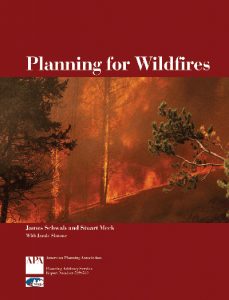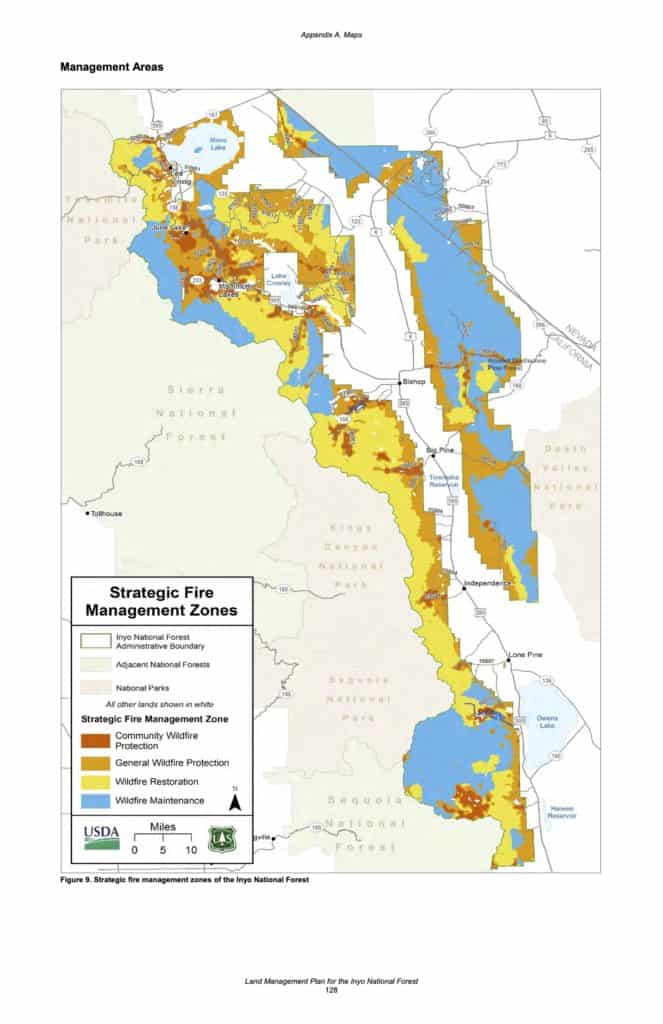(Not in the American Planning Association context of this publication, but in the NFMA context of national forests.)
I was alerted to the Tahoe situation by this supportive opinion piece in a local paper, which includes a link to the project record for the proposed plan amendment. It provides an opportunity for a look at how fire management, and in particular wildfire management for resource benefits, should be addressed in national forest planning. Fire and planning have had a rocky relationship in the Forest Service over the years, but here’s some current guidance.
Guidance for Implementation of Federal Wildland Fire Management Policy (February 2009) includes this:
Management response to a wildland fire on federal land is based on objectives established in the applicable Land/ Resource Management Plan and/or the Fire Management Plan.
Fire Management Plans, programs, and activities support land and resource management plans and their implementation.
The L/RMP will define and identify fire’s role in the ecosystem. The response to an ignition is guided by the strategies and objectives outlined in the L/RMP and/or the Fire Management Plan.
Values to be protected from and/or enhanced by wildland fire are defined in the L/RMP and/or the Fire Management Plan.
Wildland fire will be used to protect, maintain, and enhance resources and, as nearly as possible, be allowed to function in its natural ecological role. Use of fire will be based on L/RMP and associated Fire Management Plans and will follow specific prescriptions contained in operational plans.
Fire Management Plans are strategic plans that define a program to manage wildland fires based on the area’s approved land management plan.
The 2014 National Cohesive Wildland Fire Management Strategy required by the Federal Land Assistance, Management, and Enhancement Act of 2009 (FLAME Act), includes as a priority, “increasing use of wildland fire.” Figure 3.4 shows a national map: “Spatial pattern of counties where options for managing wildfires
for resource objectives and ecological purposes might prove useful.”
The Forest Service Planning Handbook advises (among other things, §23.11c):
Standards or guidelines. The plan may include standards or guidelines related to basic smoke management practices, non-fire fuels treatments, post-fire rehabilitation, prescribed fire treatments, and wildland fire responses. A guideline or standard may provide guidance on when or how a specific tool is appropriate.
Here is the language from the current Tahoe forest plan (a standard):
Fire suppression strategy is control (with fast, aggressive initial attack) except where the contain strategy is authorized for specific management areas at fire intensity levels described under the practice description. Strength of attack will be based on hazard rating, fire weather, and values at risk.
The exceptions:
The Forest Plan allows Fire Managers to utilize fire for resource benefits in only a few limited areas of the Forest and only if the fire can be contained within an isolated fuelbed of 5 acres or less, a situation rarely encountered and at a scale too small to achieve meaningful ecological restoration or other resource benefits.
Here is the comparable language proposed for the amendment (a guideline):
Use naturally- (lightning-) caused wildfire ignitions to meet multiple resource objectives when and where conditions permit and risk is within acceptable limits. Multiple resource objectives include: re-introducing fire as a necessary ecological process; enhancing plant and wildlife habitat, including critical habitat for threatened and endangered species; improving forest health, conserving ecosystem services; managing smoke emissions; reducing fuel loading; and/or protecting communities and infrastructure.
So this all sounds like an improvement, but nowhere in the proposal or the discussion of the proposal does the Forest mention the role of the forest plan. The “multiple resource objectives” should come from there. They list 14 factors, and the only one that indirectly implicates the forest plan is “cultural and natural values at risk.” A simple fix to the proposed guideline would be to use such ignitions to “achieve the desired conditions and objectives of the forest plan,” and add to the factor “… values at risk based on the forest plan.” That should go without saying, but by failing to mention the plan, it suggests that decisions about prescribed wildfires could be made without reference to that document. The forest plan may not be the first thing that comes to mind when a fire starts, but management of a fire, like everything else a national forest does, must be consistent with the applicable forest plan.
I do like the direct approach the Tahoe is taking with the smoke issue.
While the amendment could have short-term adverse effects on certain resources, for example, air quality, its effects would be largely beneficial by restoring the ecological role of fire and protecting forests and communities from the significant adverse effects of large-scale, uncharacteristic wildfire.
The proposed amendment is aimed at restoring air quality (36 CFR 219.8(a)(2)(i) by serving to offset smoke emissions from large, uncharacteristic wildfires
When forest plans are revised, a more comprehensive approach should be taken. This will give you an idea what the Inyo has done.


I really like seeing white-hat (and science-based) Forest Service projects like this. Is there organized opposition to this amendment?
Yes, I’m sure there is opposition to ALL wildfires, from folks who feel that wildfire smoke is affecting their lives very negatively. These folks even oppose prescribed fires.
Personally, I want to see such ‘Let Burn’ wildfires banned during the three peak months of fire season, due to personnel availability and extreme burning conditions.
After all, how can a fire be “natural”, when it is burning in forests which have unnatural conditions? We seem to be pushing towards using “Wildfire Acres Burned” as an ‘accomplishment’.
As I understand it, the Forest Service already uses natural and prescribed fire as part of its “acres treated” accomplishment accounting.
I think natural and prescribed fire *can* be used during the fire season, under the right field conditions and circumstances. The restoration need is too great to arbitrarily take 3 months off the table. I know not everyone agrees, though.
It seems like it is all too often that the reason for escapes on such fire use is “unforeseen weather conditions”. Well, in those high mountains, you often have high winds. I’ve spent much of my career in the higher elevations of the Sierra Nevada, including the Tahoe. I personally think this idea puts the public in danger and the Forest Service’s record on this practice is very poor. We’ve seen fires that could have been safely put out but, they ballooned up to 100,000 acres and cost $100,000,000, just to suppress. Many others went from 500 acres up to 30,000 acres. We’ve already tried that expensive and dangerous idea.
BTW, I wasn’t “arbitrarily” taking those three months of peak fire season. It is very important that we don’t tie up initial attack resources just to sit on a fire that could easily flare up. It takes away resources right when we need them the most.
I think it is extremely important that all fires during the summer months be extinguished as quickly as possible. It is not question of if the winds will come up but when. I think it is proven that FS initial response to fires is slow and that their firefighting methods tend to promote most acres burned.
That was mostly my point. However, safety is a very important issue, as well as a factor in increasing acreages. Firefighters no longer take the risks that they used to, and that is a good thing, with the extreme fire behavior we see today. We cannot sacrifice safety for increased aggressiveness in containing fires. Suppression strategies should be left to the experts.
I don’t have a problem with this amendment. It sounds vague enough that it gets the point across without hamstringing the judgment of fire suppression folks, who are, after all the ones who ultimately take the heat.
Just want people to know that at least around here having an old plan (86) doesn’t prevent folks from doing WFU, the Decker fire ran from September til November at least with the idea that winter would ultimately put it out. https://www.facebook.com/pg/DeckerFire2019/about/?ref=page_internal
I bet there are successes all around the country, regardless of plan or amendment status, that we might not hear about unless something goes wrong. I am not keen on having to go to Facebook to get info and ending up in the Zuckerberg information tracking megalith, but as someone once said, “you can’t always get what you want.”
Now, I’m not saying it isn’t good to think about it before, even analyze areas that might be most appropriate and mapping them like the GMUG did. I’m just pointing out that it’s apparently not necessary to have successful WFU.
It totally depends on what the applicable forest plan says. Some are silent, some specifically require full suppression all the time everywhere, and some are in the middle. I’d like to see some consistency, particularly in the forests where fire is part of the ecology. Thankfully, the 2012 Planning Rule encourages such thinking, but I’m still waiting to see how revised plans turn out and whether they take the initiative. The Inyo plan goes in this direction.
The Tahoe forest plan had language that clearly restricted its ability to do anything other than suppress wildfires. I don’t know how many other forest plans do the same, but I have generally understood that many allow wildfire use only in wilderness areas. Once the national policy to encourage it was in place, there should have been a national effort to conform forest plans that did not comply with the policy.
(I have just added a map from the Inyo revised plan to the original post above.)
It would be interesting to get a table of all the WFU fires from the last ten years, look at the acreages, and compare the acres with forest plan language.
If the language is holding up WFU in practice, I’d put some revisions on hold and spend the buck to pay for forests to do WFU amendments. Or even multi-regional surgical language amendment to something like “where it makes sense, …”.
My goodness I’m glad I’m not on the Tahoe… but glad to see they’re updating that very restrictive language from their forest plan.